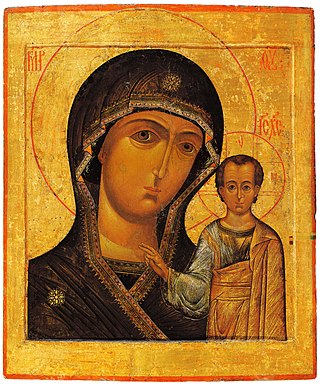
Theotokos is a title of Mary, mother of Jesus, used especially in Eastern Christianity. The usual Latin translations are Dei Genitrix or Deipara. Familiar English translations are "Mother of God" or "God-bearer" – but these both have different literal equivalents in Greek, Μήτηρ Θεοῦ and Θεοφόρος.
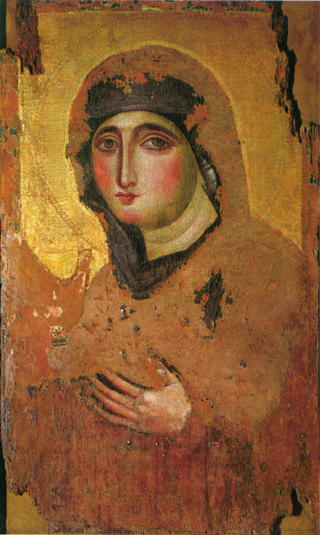
Mary was a first-century Judean woman of Nazareth, the wife of Joseph and the mother of Jesus. She is a central figure of Christianity, venerated under various titles such as virgin or queen, many of them mentioned in the Litany of Loreto. The Eastern and Oriental Orthodox, Church of the East, Catholic, Anglican, and Lutheran churches believe that Mary, as mother of Jesus, is the Mother of God. Other Protestant views on Mary vary, with some holding her to have considerably lesser status.
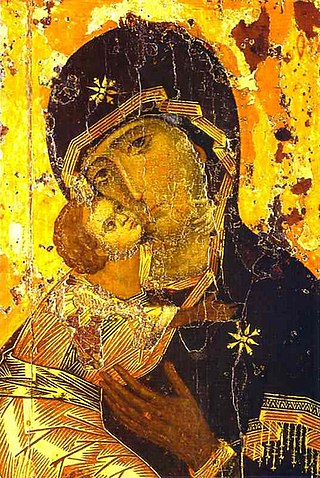
The perpetual virginity of Mary is a Christian doctrine that Mary, the mother of Jesus, was a virgin "before, during and after" the birth of Christ. In Western Christianity, the Catholic Church adheres to the doctrine, as do some Lutherans, Anglicans, Reformed, and other Protestants. Shenouda III, Pope of the Coptic Orthodox Church, affirmed the teaching, and Eastern Orthodox churches recognize Mary as Aeiparthenos, meaning "ever-virgin". It is one of the four Marian dogmas of the Catholic Church. Most modern nonconformist Protestants reject the doctrine.

Catholic Mariology is Mariology in Catholic theology. According to the Immaculate Conception taught by the Catholic Church, she was conceived and born without sin, hence Mary is seen as having a singular dignity above the saints, receiving a higher level of veneration than all angelic spirits and blessed souls in heaven. Catholic Mariology thus studies not only her life but also the veneration of her in daily life, prayer, hymns, art, music, and architecture in modern and ancient Christianity throughout the ages.

Marian devotions are external pious practices directed to the person of Mary, mother of God, by members of certain Christian traditions. They are performed in Catholicism, High Church Lutheranism, Anglo-Catholicism, Eastern Orthodoxy and Oriental Orthodoxy, but generally rejected in other Christian denominations.

The term Evangelical Catholic is used in Lutheranism, alongside the terms Augsburg Catholic or Augustana Catholic, with those calling themselves Evangelical Catholic Lutherans or Lutherans of Evangelical Catholic churchmanship stressing the catholicity of historic Lutheranism in liturgy, beliefs, practices, and doctrines. Evangelical Catholics teach that Lutheranism at its core "is deeply and fundamentally catholic". The majority of Evangelical Catholic Lutheran clergy and parishes are members of mainstream Lutheran denominations.
Anglican Marian theology is the summation of the doctrines and beliefs of Anglicanism concerning Mary, mother of Jesus. As Anglicans believe that Jesus was both human and God the Son, the second Person of the Trinity, within the Anglican Communion and Continuing Anglican movement, Mary is accorded honour as the theotokos, a Koiné Greek term that means "God-bearer" or "one who gives birth to God".

Mary, the mother of Jesus in Christianity, is known by many different titles, epithets, invocations, and several names associated with places.

Mariology is the theological study of Mary, the mother of Jesus. Mariology seeks to relate doctrine or dogma about Mary to other doctrines of the faith, such as those concerning Jesus and notions about redemption, intercession and grace. Christian Mariology aims to place the role of the historic Mary in the context of scripture, tradition and the teachings of the Church on Mary. In terms of social history, Mariology may be broadly defined as the study of devotion to and thinking about Mary throughout the history of Christianity.
Marian feast days in the liturgical year are celebrated in honour of the Blessed Virgin Mary. The number of Marian feasts celebrated, their names can vary among Christian denominations.

Protestant views on Mary include the theological positions of major Protestant representatives such as Martin Luther and John Calvin as well as some modern representatives. While it is difficult to generalize about the place of Mary, mother of Jesus in Protestantism given the great diversity of Protestant beliefs, some summary statements are attempted.
Karl Barth's views on Mary agreed with much Roman Catholic dogma but disagreed with the Catholic veneration of Mary. Barth, a leading 20th-century theologian, was a Reformed Protestant. Aware of the common dogmatic tradition of the early Church, Barth fully accepted the dogma of Mary as the Mother of God. Through Mary, Jesus belongs to the human race. Through Jesus, Mary is Mother of God.

The history of Catholic Mariology traces theological developments and views regarding Mary from the early Church to the 21st century. Mariology is a mainly Catholic ecclesiological study within theology, which centers on the relation of Mary, the Mother of God, and the Church. Theologically, it not only deals with her life but with her veneration in life and prayer, in art, music, and architecture, from ancient Christianity to modern times.

Throughout history, Catholic Mariology has been influenced by a number of saints who have attested to the central role of Mary in God's plan of salvation. The analysis of Early Church Fathers continues to be reflected in modern encyclicals. Irenaeus vigorously defended the title of "Theotokos" or Mother of God. The views of Anthony of Padua, Robert Bellarmine and others supported the doctrine of the Immaculate Conception of the Virgin Mary, which was declared a dogma in 1850.

John Calvin (1509–1564) was a French Protestant theologian during the Protestant Reformation, and one of the most influential reformers. He was a central figure for the Reformed churches, whose theological system is sometimes called Calvinism.

Ecumenical meetings and documents on Mary, involving ecumenical commissions and working groups, have reviewed the status of Mariology in the Eastern Orthodox, Lutheran, Anglican, and Roman Catholic Churches.
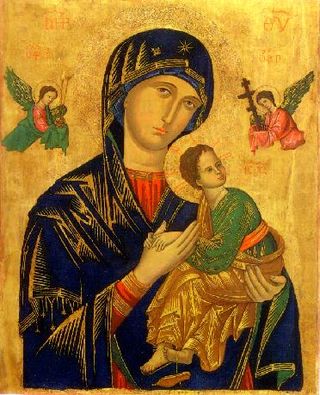
Mary has been one of the major subjects of Western Art for centuries. There is an enormous quantity of Marian art in the Catholic Church, covering both devotional subjects such as the Virgin and Child and a range of narrative subjects from the Life of the Virgin, often arranged in cycles. Most medieval painters, and from the Reformation to about 1800 most from Catholic countries, have produced works, including old masters such as Michelangelo and Botticelli.
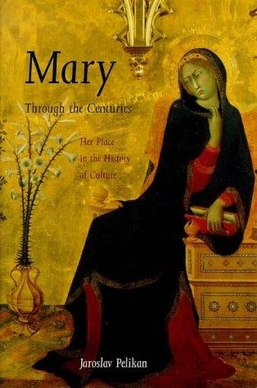
Mary Through the Centuries: Her Place in the History of Culture is a book by Jaroslav Pelikan, published in New Haven by Yale University Press in 1996. It is based on the 1962 publication of Walter Tappolet, Das Marienlob der Reformatoren. Mary Through The Ages is a collection of texts from Martin Luther, John Calvin, Huldrych Zwingli, and Heinrich Bullinger, whom Pelikan called "the Reformers in Praise of Mary".
The following outline is provided as an overview of and topical guide to the Catholic Church:
Protestant theology refers to the doctrines held by various Protestant traditions, which share some things in common but differ in others. In general, Protestant theology, as a subset of Christian theology, holds to faith in the Christian Bible, the Holy Trinity, salvation, sanctification, charity, evangelism, and the four last things.



















